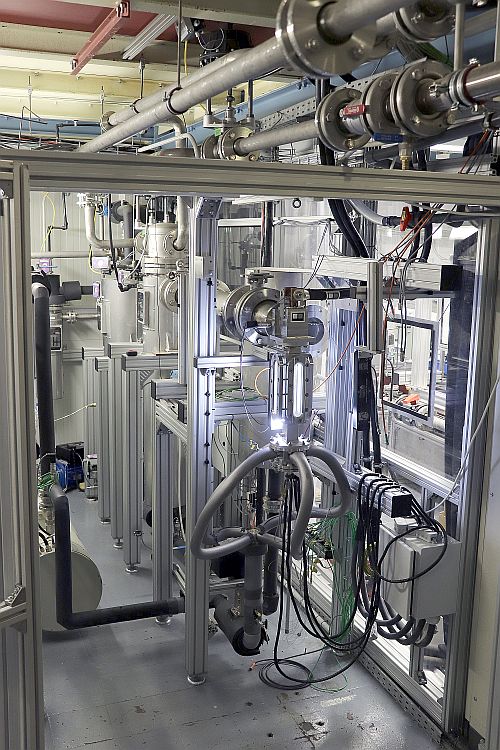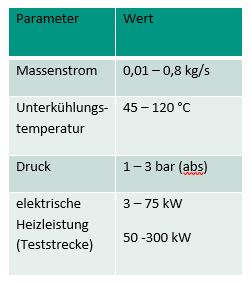COSMOS-L
Critical-heat-flux On Smooth and Modified Surfaces – Low pressure loop
Contact: stephan.gabriel∂kit.edu; giancarlo.albrecht∂kit.edu
The COSMOS-L thermohydraulics trainer (Figure 1) is used to study complex flow and heat transfer phenomena in boiling flows relevant to power engineering. The facility is operated with fully demineralized water as the experimental medium and is electrically heated. Powerful measurement and control technology allows measurements up to boiling cries. Some important plant parameters can be taken from table 1.
|
|
Table 1: Plant parameters |
The plant is extensively instrumented. Numerous parameters are measured, which record the plant condition with regard to thermohydraulics and other variables such as water quality. In addition, there is the test setup with its specific instrumentation. Particularly noteworthy is the temperature measurement at the heater, which is able to detect an occurring boiling crisis very quickly and to discontinue the heater output before the heater is damaged. In the test section, various test arrangements can be used, from flat heaters to individual heating tubes to heated rod bundles.
To date, two different test sections have been used for measurements under real-world conditions. C. Haas developed an annular gap test section (Figure 2) as part of his dissertation, which has been continuously developed and modernized to date.

Figure 2: Annular gap test section at COSMOS-L
The test section consists of a single heating tube in a flow-through annular gap, which is enclosed from the outside by a glass tube. Through the glass, the boiling flow can be observed over the full heated length of 32 cm. This also makes the use of (laser) optical measurement methods possible.
The second test section (Figure 3) has a square cross-section and contains a rod bundle of five or nine heating tubes whose heating power can be controlled individually and independently of each other. This makes it possible to realize different power distributions. This allows different boundary conditions to be created and the instrumentation to be concentrated at the location where the phenomenon to be observed, e.g. the boiling crisis, is most likely to occur.

Figure 3. rod bundle test section at COSMOS-L
Since the start of plant operation, numerous tests have been performed as part of final theses and funded projects. Selected publications are listed below:
- C. Haas: “Critical Heat Flux for Flow Boiling of Water at Low Pressure on Smooth and Micro-Structured Zircaloy Tube Surfaces”. Dissertation, KIT Scientific Reports No. 7627. Karlsruhe 2012 https://www.ksp.kit.edu/9783866449237
- C. Haas, F. Kaiser, T. Schulenberg, T. Wetzel: “Critical heat flux for flow boiling of water on micro-structured zircaloy tube surfaces”. International Journal of Heat and Mass Transfer, 120 (2018) 793-806
- Th. Frank, Amine Ben Hadj Ali, Conxita Lifante, Moritz Bruder, Florian Kaiser, Henning Eickenbusch: "Prediction of Convective Boiling up to Critical Heat Flux (CHF) Conditions for Test Facilities with Vertical Heaters". 15th Joint HZDR & ANSYS Conference "Multiphase Flows: Simulation, Experiment and Application". Helmholtz Zentrum Dresden-Rossendorf (HZDR), Germany, 14.-17. November 2017.
- Th. Frank, Amine Ben Hadj Ali, Conxita Lifante, Florian Kaiser, Stephan Gabriel, Henning Eickenbusch: "Modeling of Wall-boiling Phenomena from Nucleate Subcooled Boiling up to CHF Conditions". 13. ERCOFTAC Technologietag, ERCOFTAC Pilotzentren Deutschland Süd und Nord, Internationales Begegnungszentrum "Eulenhof" der Universität Stuttgart, Germany, 30. November 2017. ERCOFTAC = European Research Community on Flow,Turbulence and Combustion.
- C. Lifante, A. Ben Hadj Ali, H. Eickenbusch, ANSYS Germany M. Bruder TU-München, F. Kaiser, S. Gabriel KIT: PREDICTION OF CONVECTIVE BOILING UP TO CRITICAL HEAT FLUX (CHF) CONDITIONS FOR TEST FACILITIES WITH VERTICAL HEATERS, ICONE-27, Japan, May 19-24, 2019
For further information or datasets, please contact the above mentioned contacts.


